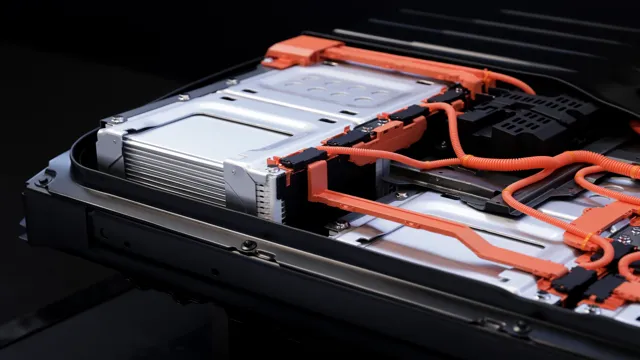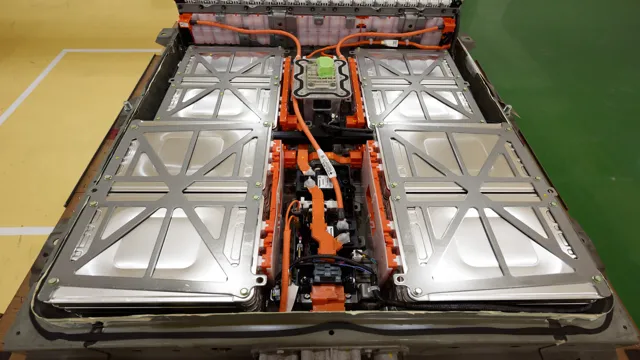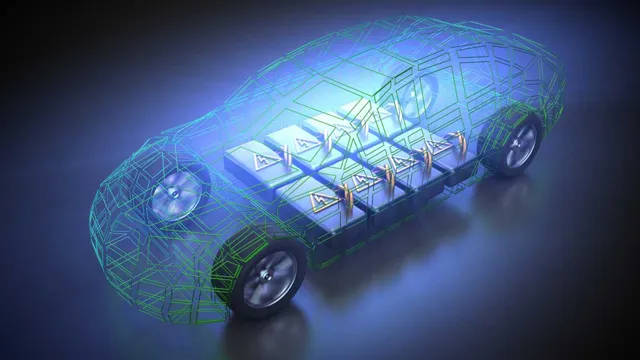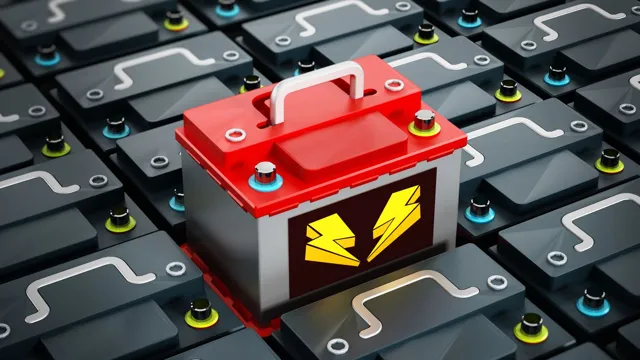Unveiling the Secrets of Electric Car Battery Utilization: Maximizing Efficiency and Sustainability!
Electric cars are becoming more popular as the world looks to find ways to reduce its carbon footprint and move towards more sustainable sources of energy. One of the key factors in making these cars more efficient and accessible is the use of electric car batteries. These batteries are designed to power the vehicles and provide a longer range than traditional fossil-fuel-powered cars.
However, the question of how to best utilize these batteries is still up for debate. In this blog, we will explore the different ways electric car batteries can be utilized, including the benefits and drawbacks of each method. So, if you are interested in the electric car revolution and how battery utilization plays a role, keep reading.
History of Electric Car Batteries
The history of electric car batteries date back to the mid-19th century when rechargeable batteries were first used in telegraph machines. However, it wasn’t until the late 1800s when electric cars started becoming popular and rechargeable batteries were utilized to power them. Early batteries were bulky, heavy and didn’t last long.
Improvements were made over the years, but it wasn’t until the 1990s when electric car battery technology began to see significant advancements. Lithium-ion batteries quickly became the go-to battery for electric vehicles due to their high energy densities and ability to store more energy in a small space. Today, scientists and researchers continue to work on improving electric car batteries, with the aim of creating more durable and efficient batteries that can help contribute to a more sustainable future.
From Lead-Acid to Lithium-Ion
Electric Car Batteries Electric car batteries have come a long way since the first crude attempts at electric cars in the early 1800s. The earliest batteries were bulky lead-acid batteries, which were heavy and inefficient. However, modern electric car batteries have evolved to use lithium-ion technology.
Lithium-ion batteries are smaller, lighter, and more efficient than lead-acid batteries. They are also more durable and can store more energy, allowing electric cars to travel longer distances on a single charge. As technology advances, the cost of lithium-ion batteries is also decreasing, making electric cars more accessible to the average consumer.
With this new technology, consumers can also expect to see electric car batteries continue to evolve and improve in the years to come.

Battery Capacity and Range
Electric car battery utilization plays a crucial role in determining the range that a vehicle can cover. When it comes to battery capacity, the more energy stored in the battery means that the car can travel for a longer distance. However, battery utilization is not always at 100% and can vary based on driving conditions and temperature.
For instance, batteries are less efficient in colder temperatures, which can decrease the range of the car. Similarly, aggressive driving style can cause the battery to discharge quicker and reduce its overall range. It is essential to keep an eye on the battery and plan your trips accordingly.
Manufacturers are also working on increasing battery capacity and improving efficiency to enhance the range of electric cars. However, for now, it is vital to understand the impact of battery utilization on the range of your electric vehicle.
Maximizing Efficiency with Regenerative Braking
When it comes to maximizing electric vehicle efficiency, regenerative braking is a game-changer. By converting kinetic energy into electrical energy, regenerative braking can recharge the vehicle’s battery while reducing wear on the brakes. But what impact does this have on the battery capacity and range of the vehicle? Well, it all depends on the driving conditions.
In stop-and-go traffic, where regenerative braking can be utilized frequently, the battery can actually gain enough charge to increase the overall range of the vehicle. On the other hand, a lot of highway driving with less frequent regenerative braking can have a minimal impact on the battery’s capacity and range. However, overall, regenerative braking can help to extend battery life and ultimately maximize the efficiency of electric vehicles.
Impact of Temperature on Battery Life
When it comes to electric vehicles, the temperature outside can have a significant impact on your battery’s capacity and range. Hot weather can cause your battery to degrade faster, reducing its overall lifespan and ability to hold a charge. On the other hand, extremely cold weather can also cause your battery’s capacity to drop and reduce its range, making it harder to drive long distances.
This is because extreme temperatures can alter the chemical reactions inside the battery cells, causing them to work less efficiently. Just like humans perform better in moderate temperatures, so do electric vehicle batteries. The key is to keep your battery from experiencing any extreme temperatures for long periods of time in order to preserve its performance and extend its lifespan.
Charging and Discharging Batteries
When it comes to electric car battery utilization, it’s important to understand the charging and discharging process. Charging a battery involves transferring electrical energy to the battery, which is stored as chemical energy. The process of discharging the battery reverses this, converting the chemical energy back into electrical energy.
Ensuring optimal battery utilization involves balancing these processes and monitoring the state of charge. Overcharging can cause damage to the battery, while undercharging can result in reduced range and performance. It’s important to follow manufacturer recommendations for charging and discharging, and to avoid rapid charging or discharging whenever possible.
Overall, the key to maximizing the lifespan and performance of an electric car battery is to practice smart charging habits and pay attention to the battery’s state of charge.
Fast vs. Slow Charging
Charging and discharging batteries is an essential aspect of any electronic device that runs on battery power. When it comes to charging, there are two options available: fast charging and slow charging. Fast charging allows you to charge your device quickly, while slow charging is a more gradual process.
Fast charging is suitable for those who need to charge their device quickly and on the go. This option typically requires a more powerful charger and results in a higher rate of energy consumption. However, it can save time and help ensure that your device is ready to use when you need it.
On the other hand, slow charging is a more gentle approach to charging your device and can help prolong the lifespan of your battery. While it might take longer to charge your device, this method is less taxing on the battery and can ultimately result in a longer overall battery life. When it comes to choosing between fast and slow charging, it ultimately depends on your needs and preferences.
If you need your device charged quickly, fast charging is the way to go. However, if you’re looking to extend the life of your battery, slow charging might be the better option. Either way, it’s important to follow the manufacturer’s guidelines and use the appropriate charger for your device to ensure optimum performance and safety.
Preventing Overcharging and Undercharging
Charging and discharging batteries are critical processes that need to be handled with care to prolong the battery’s life and prevent damage. Overcharging and undercharging are common issues that can lead to significant problems. Overcharging can cause the battery to overheat and, in extreme cases, even explode.
On the other hand, undercharging can cause the battery to become drained, leading to reduced capacity and lifespan. To prevent these issues, it’s essential to ensure that batteries are charged and discharged at the recommended levels. Moreover, choosing the right charger that matches the battery’s requirements is equally important.
A high-quality charger will detect when the battery is full and automatically stop the charging process to prevent overcharging. It’s also critical to store the battery in a cool and dry place to keep it from losing charge or becoming damaged. By taking these precautions, you can maintain the health of your batteries and ensure they function optimally for an extended period.
Future Developments in Battery Technology
Electric car battery utilization is at the forefront of technological advancements in the automobile industry. As the market for electric cars grows, manufacturers are looking for ways to improve battery efficiency and capacity. One promising development involves the use of solid-state batteries, which replace the liquid electrolyte found in traditional lithium-ion batteries with a solid material.
Solid-state batteries offer improved safety, longer lifespan, and greater energy density, meaning they can store more energy in a smaller space. Another potential improvement is the use of lithium-sulfur batteries, which have the potential to store more than five times the energy of traditional lithium-ion batteries. With these advancements, electric cars could soon be powered by batteries that have longer ranges, charge faster, and last longer than ever before.
As a result, electric cars could become even more practical for everyday use, helping to reduce the world’s dependence on fossil fuels and combat climate change.
Solid State Batteries
Battery technology is one of those things that affects our everyday lives more than we might think. With the growing demand for cleaner energy sources and the advent of electric cars, it becomes even more important to develop batteries that are both efficient and long-lasting. Enter the solid-state battery, a technology that could revolutionize the way we store energy.
Instead of using a liquid electrolyte, these batteries use a solid one, which makes them more durable and safer. Moreover, they offer a higher energy density, which means that they can store more energy in a smaller package. While still in development, there is hope that solid-state batteries will become a viable alternative to traditional lithium-ion batteries in the near future.
Once perfected, this could lead to better electric cars, longer-lasting smartphones, and more efficient energy storage systems for homes and businesses.
Wireless Charging
Wireless Charging Battery technology has come a long way in recent years, but the focus is now on wireless charging. With this technology, users can charge their battery without having to plug it into a wall socket or power source. Many companies are investing in wireless charging technology, and we can expect to see further innovations in this area in the future.
We can expect to see faster charging speeds, improved battery efficiency, and even the ability to charge multiple devices simultaneously. As more devices are able to be charged wirelessly, we will no longer need to carry multiple chargers around with us. This technology has the potential to revolutionize the way we charge our devices, making our lives easier and more convenient.
In the future, we may even see wireless charging integrated into everyday products, such as furniture and cars, allowing for a completely seamless charging experience. Overall, wireless charging is a game-changer in the battery industry and is a development that we should all be excited about.
Conclusion
In conclusion, electric car batteries are like the superheroes of the automotive world, silently working hard to power our vehicles without any harmful emissions. With smart utilization and management, we can ensure that these batteries continue to be a force for good in the fight against climate change. So let’s charge forward into a brighter, cleaner, and more sustainable future with electric car batteries leading the way!”
FAQs
What is electric car battery utilization?
Electric car battery utilization refers to the efficient use of the battery power in an electric car for maximum driving distance and performance.
How does electric car battery utilization differ from traditional gasoline cars?
Traditional gasoline cars rely on combustion to generate power, whereas electric cars rely on battery power. Therefore, maximizing battery utilization is critical for electric car performance.
What factors affect electric car battery utilization?
Factors such as driving behavior, weather conditions, terrain, and car maintenance can all impact electric car battery utilization.
How can I improve electric car battery utilization?
You can improve battery utilization by practicing efficient driving habits, such as coasting and regenerative braking, avoiding extreme temperatures, and properly charging and maintaining the battery.




